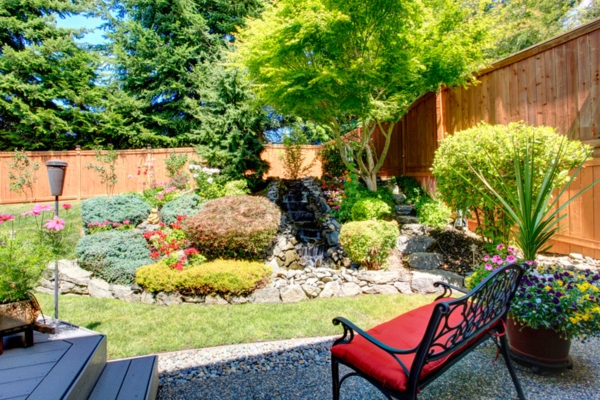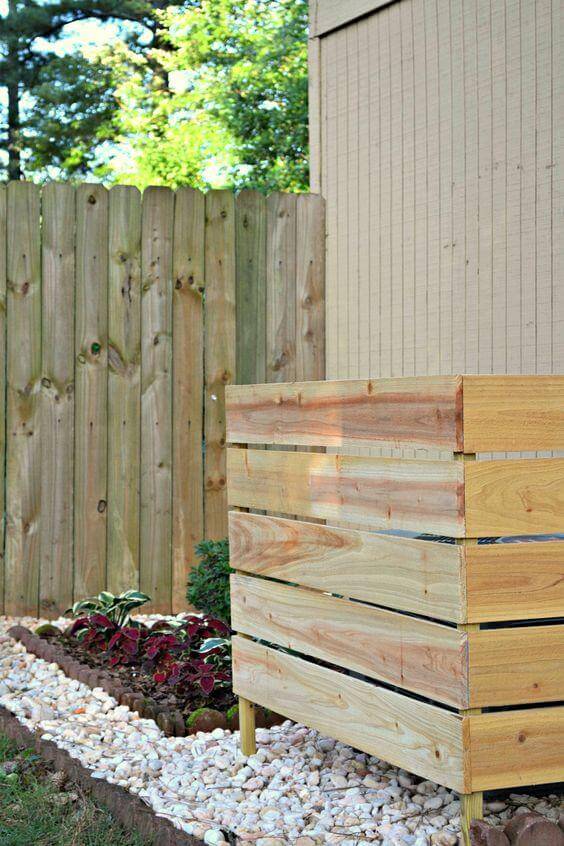Disclosure: This post contains affiliate links and I will be compensated if you make a purchase after clicking through my links. Learn More
To hide an outdoor generator, use a combination of landscaping elements and enclosures. Ensure proper ventilation and accessibility for maintenance.
Outdoor generators are essential for backup power but can be eyesores in your yard. Concealing them effectively enhances your landscape’s aesthetics. Consider using natural elements like shrubs, tall grasses, or lattice panels to blend the generator into its surroundings. Custom-built enclosures or storage sheds can also provide a neat solution while maintaining easy access for servicing.
Choose materials and designs that match your home’s exterior to create a seamless look. Proper ventilation is crucial to ensure the generator operates efficiently and safely. Planning your concealment strategy thoughtfully can make your generator an unobtrusive part of your outdoor space.
Choosing The Right Location
Hiding an outdoor generator can improve your home’s aesthetic. Choose the right location to ensure safety and efficiency. The location should be accessible, flood-free, and out of sight.
Consider Accessibility
Always ensure your generator is easily accessible. You might need to perform maintenance or refuel it. Keep a clear path to the generator. This will save time during emergencies.
Avoid Flood-prone Areas
Generators should be placed in areas not prone to flooding. Water can damage electrical components. A high ground location is best. This ensures your generator stays dry and functional.
| Location Feature | Importance |
|---|---|
| Accessible Path | High |
| High Ground | High |
| Out of Sight | Medium |
- Ensure easy access for maintenance.
- Avoid flood-prone areas for safety.
- Choose a location out of sight for aesthetics.

Using Natural Landscaping
Hiding an outdoor generator can be easy. Natural landscaping makes it blend in better. It also makes your yard look nice. You can use plants, rocks, and other natural things.
Plant Shrubs And Trees
Shrubs and trees are great for hiding generators. They grow tall and wide. This can make the generator disappear. Pick plants that grow well in your area.
Here are some good plants to use:
- Evergreen shrubs
- Fast-growing trees
- Flowering bushes
Make sure to plant them close enough. This way, they cover the generator well. Water them often so they grow fast.
Create A Rock Garden
A rock garden can hide your generator too. Rocks come in many shapes and sizes. They look natural and are easy to arrange.
Here’s how to create a rock garden:
- Pick a spot around the generator.
- Lay down some large rocks first.
- Add smaller rocks around them.
- Fill gaps with pebbles or gravel.
You can also add some plants between the rocks. This makes it look even better.
Building Enclosures
Outdoor generators are essential for backup power, but they can be unsightly. Building enclosures is an effective way to hide them. This not only improves aesthetics but also offers protection. Below are some popular options for building enclosures.
Wooden Fences
Wooden fences are a classic choice for hiding outdoor generators. They blend well with most landscapes and are relatively easy to install.
- Material: Choose pressure-treated wood for durability.
- Design: Use horizontal or vertical slats.
- Ventilation: Ensure there are gaps for air circulation.
Wooden fences can be customized with paint or stain. This helps match your home’s exterior. They also offer easy access for maintenance.
Brick Walls
Brick walls offer a more permanent and durable solution. They provide excellent protection and can be built to match your home’s architecture.
- Material: Use weather-resistant bricks.
- Design: You can opt for a solid or partial wall.
- Ventilation: Include vents for proper airflow.
Brick walls are low-maintenance and highly durable. They can withstand harsh weather conditions. This option is ideal for long-term solutions.
| Type | Material | Design | Ventilation |
|---|---|---|---|
| Wooden Fences | Pressure-treated wood | Horizontal or vertical slats | Gaps for air circulation |
| Brick Walls | Weather-resistant bricks | Solid or partial wall | Include vents |

Decorative Screens
Decorative screens are an excellent way to hide an outdoor generator. They offer a stylish solution that enhances your garden’s beauty. Let’s explore some attractive options.
Lattice Panels
Lattice panels are a popular choice for hiding generators. They provide a blend of functionality and aesthetics.
These panels are easy to install and allow airflow. They also support climbing plants, adding a natural touch. Available in various materials like wood and vinyl, lattice panels can suit any garden style.
| Material | Pros | Cons |
|---|---|---|
| Wood | Natural look, customizable | Requires maintenance |
| Vinyl | Durable, low maintenance | Less natural appearance |
Bamboo Screens
Bamboo screens provide an eco-friendly way to hide your generator. They offer a unique and exotic look.
These screens are lightweight yet sturdy. Bamboo screens are also easy to move and adjust. They blend well with various garden themes and are available in different heights and thicknesses.
- Eco-friendly and sustainable
- Resistant to weather
- Easy to install and adjust
Choose bamboo screens for a natural and aesthetic solution to hiding your generator. They will enhance your garden’s appeal while serving their purpose.
Camouflaging With Paint
Camouflaging your outdoor generator can make it blend with your yard. Using paint is an easy and effective way to hide it. Let’s explore how to use paint to match your generator with its surroundings.
Match Surroundings
Choose colors that match your generator’s surroundings. Look at the colors in your yard.
- Green for grass and plants
- Brown for wooden fences or dirt
- Grey for concrete or stone
Using these colors helps make the generator less visible. It will blend in and not stand out.
Use Weather-resistant Paint
Weather-resistant paint ensures the paint lasts longer. It protects the generator from rain, sun, and wind.
- Clean the generator’s surface.
- Apply a primer for better paint adhesion.
- Paint with weather-resistant paint.
Following these steps ensures your generator stays camouflaged for years. Pick the best paint for outdoor conditions.

Multi-functional Covers
Hiding an outdoor generator can be a challenge. One effective solution is to use multi-functional covers. These covers not only conceal your generator but also add functionality to your outdoor space. Below are some creative ideas.
Storage Sheds
A storage shed is a great way to hide your generator. Sheds come in various sizes and styles to match your outdoor decor. Choose a shed with enough ventilation to keep the generator cool.
- Wooden sheds blend well with gardens.
- Metal sheds offer durability.
- Plastic sheds are easy to maintain.
| Type | Benefits |
|---|---|
| Wooden | Blends with garden |
| Metal | Durable |
| Plastic | Low maintenance |
Outdoor Benches
An outdoor bench can also serve as a generator cover. This is a smart way to add seating while hiding your generator.
- Choose a bench with a hidden storage compartment.
- Ensure the bench has proper ventilation.
- Pick materials that match your outdoor furniture.
Outdoor benches come in various designs. Opt for one that complements your garden or patio. You can find benches made of wood, metal, or plastic. Each material has its own benefits.
Soundproofing Solutions
Generators can be noisy, disturbing your peace. Soundproofing your generator can help. Here, we discuss different ways to reduce noise. These methods are easy and effective. Let’s dive into soundproofing solutions.
Read More: How to Build a Soundproof Box for a Generator
Install Insulation
Insulation reduces noise by absorbing sound waves. You can use foam or fiberglass insulation. Both work well to keep your generator quiet.
- Measure the generator enclosure first.
- Cut the insulation to fit the walls.
- Secure it with adhesive or nails.
Ensure all gaps are filled. This will maximize the noise reduction. Insulation works best when installed properly.
Add Acoustic Panels
Acoustic panels are another great option. These panels absorb sound and reduce noise. They are easy to install and very effective.
- Purchase high-quality acoustic panels.
- Cut them to fit the generator enclosure.
- Attach them to the walls and ceiling.
You can use screws or adhesive to attach the panels. Make sure they cover all surfaces. This will provide the best noise reduction.
Acoustic panels come in different styles. Choose ones that blend with your outdoor space. This way, they won’t be noticeable.
Maintaining Ventilation
Proper ventilation is crucial for the safe and efficient operation of an outdoor generator. Without sufficient airflow, generators can overheat, leading to potential damage and safety hazards. This section will guide you on how to maintain ventilation while hiding your generator effectively.
Ensure Airflow
Generators need adequate airflow to function correctly. Blocking the ventilation can cause serious problems. Here are some tips to ensure proper airflow:
- Place the generator in an open area.
- Avoid enclosing it in tight spaces.
- Use lattice screens or slatted panels to hide it.
A lattice screen allows air to circulate freely. Slatted panels provide both camouflage and airflow. Ensure that the screens or panels are at least three feet away from the generator. This distance allows enough room for air to move and prevents overheating.
Prevent Overheating
Overheating can damage the generator and pose a safety risk. Follow these tips to prevent overheating:
- Regularly check the generator for dust and debris.
- Clean the air filters periodically.
- Ensure that the exhaust is not blocked.
A table can help you keep track of maintenance tasks:
| Task | Frequency |
|---|---|
| Check for dust and debris | Weekly |
| Clean air filters | Monthly |
| Inspect exhaust system | Weekly |
By following these steps, you can ensure your generator operates safely. Proper maintenance is key to preventing overheating and prolonging the lifespan of your equipment.
Frequently Asked Questions
How Can I Hide My Outdoor Generator?
You can hide it using a privacy fence, plants, or a custom-built enclosure.
What Plants Are Best For Hiding Generators?
Evergreen shrubs like boxwood or holly are ideal. They provide year-round coverage and are easy to maintain.
Can I Build An Enclosure For My Generator?
Yes, you can build a wooden or metal enclosure. Ensure it has proper ventilation to prevent overheating.
Is It Safe To Cover A Generator With A Tarp?
No, using a tarp can restrict airflow and cause the generator to overheat. Always use proper enclosures.
Final Words
Properly hiding your outdoor generator boosts your home’s aesthetics and functionality. Use creative solutions to blend it seamlessly. Ensure adequate ventilation and easy access for maintenance. With these tips, your generator can be both discreet and efficient. Enjoy a visually pleasing and reliable power source in your outdoor space.


